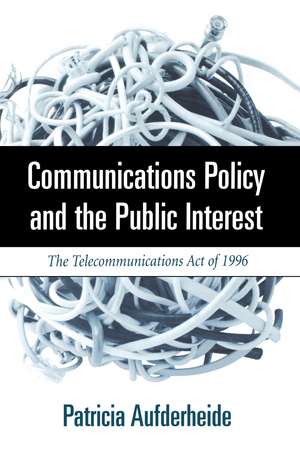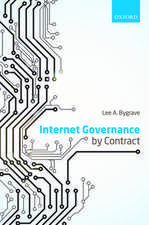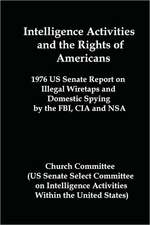Communications Policy and the Public Interest: The Telecommunications Act of 1996: The Guilford Communication Series
Autor Patricia A. Aufderheideen Limba Engleză Paperback – 18 feb 1999
The passage of the Telecommunications Act of 1996 inaugurated a new and highly volatile era in telecommunications. The first major overhaul of U.S.
communications law since 1934--when no one had a television set, a cordless phone, or a computer--the Act was spurred into being by broad shifts in technology use. Equally important, this book shows, the new law reflects important changes in our notions of the purpose of communications regulation and how it should be deployed. Focusing on the evolution of the concept of the public interest, Aufderheide examines how and why the legislation was developed, provides a thematic analysis of the Act itself, and charts its intended and unintended effects in business and policy. An abridged version of the Act is included, as are the Supreme Court decision that struck down one of its clauses, the Communications Decency Act, and a variety of pertinent speeches and policy arguments. Readers are also guided to a range of organizations and websites that offer legal updates and policy information.
communications law since 1934--when no one had a television set, a cordless phone, or a computer--the Act was spurred into being by broad shifts in technology use. Equally important, this book shows, the new law reflects important changes in our notions of the purpose of communications regulation and how it should be deployed. Focusing on the evolution of the concept of the public interest, Aufderheide examines how and why the legislation was developed, provides a thematic analysis of the Act itself, and charts its intended and unintended effects in business and policy. An abridged version of the Act is included, as are the Supreme Court decision that struck down one of its clauses, the Communications Decency Act, and a variety of pertinent speeches and policy arguments. Readers are also guided to a range of organizations and websites that offer legal updates and policy information.
Finalist, McGannon Center Award for Social and Ethical Relevance in Communication Policy Research
Preț: 340.33 lei
Nou
Puncte Express: 510
Preț estimativ în valută:
65.12€ • 69.64$ • 54.30£
65.12€ • 69.64$ • 54.30£
Carte tipărită la comandă
Livrare economică 17 aprilie-01 mai
Preluare comenzi: 021 569.72.76
Specificații
ISBN-13: 9781572304253
ISBN-10: 1572304251
Pagini: 323
Dimensiuni: 152 x 229 x 23 mm
Greutate: 0.46 kg
Ediția:Prescurtată
Editura: Guilford Publications
Colecția Guilford Press
Seria The Guilford Communication Series
ISBN-10: 1572304251
Pagini: 323
Dimensiuni: 152 x 229 x 23 mm
Greutate: 0.46 kg
Ediția:Prescurtată
Editura: Guilford Publications
Colecția Guilford Press
Seria The Guilford Communication Series
Public țintă
Postgraduate and Professional Practice & DevelopmentCuprins
Introduction
1. Background
2. The Shaping of the 1996 Act
3. Overview of the Act
4. After the Act
5. The Public Interest beyond the Act
Bibiliographic Resources
References
Annotated Guide to Analyses of the Act, 1996-1997
Resources for Active Citizens
Appendices
Government Documents:
A. Abridged Version of the Telecommunications Act of 1996, Dean Thomas Krattenmaker
B. Syllabus and Opinion of Supreme Court Opinion No. 95-611, Janet Reno, Attorney General of the United States, et al,. Appellants, v. American Civil Liberties Union et al., June 26, 1997, with concurrence by Justices O'Connor and Rehnquist
Position Papers on Regulation and the Public Interest:
C. Serving the Community: A Public Interest Vision of the National Information Infrastructure (abridged), Computer Professionals for Social Responsibility (1993)
D. Seven Public Interest Principles of the Telecommunications Policy Roundtable (1993)
E. Cyberspace and the American Dream: A Magna Carta for the Knowledge Age, The Progress and Freedom Foundation (1994)
F. Technorealism: An Overview, D. Bennahum, B. Biggs, P. Borsook, M. Bowe, S. Garfinkel, S. Johnson, D. Rushkoff, A. Shapiro, D. Shenk, S. Silberman, M. Stahlman, and S. Syman (1997)
G. Why Government Is the Solution, and Not the Problem, Gigi Sohn, Executive Director, Media Access Project (1997)
H. Interview with an Umpire, Michael Katz (1995)
FCC Speeches:
I. The Hard Road Ahead: An Agenda for the FCC in 1997, Chairman Reed Hundt, Federal Communications Commission
J. The Light at the End of the Tunnel vs. the Fog: Deregulation vs. the Legal Culture, Chairman Reed Hundt, Federal Communications Commission (1997)
K. Remarks by William Kennard, Chairman, Federal Communications Commission, to the National Association of State Utility Consumer Advocates (1998)
1. Background
2. The Shaping of the 1996 Act
3. Overview of the Act
4. After the Act
5. The Public Interest beyond the Act
Bibiliographic Resources
References
Annotated Guide to Analyses of the Act, 1996-1997
Resources for Active Citizens
Appendices
Government Documents:
A. Abridged Version of the Telecommunications Act of 1996, Dean Thomas Krattenmaker
B. Syllabus and Opinion of Supreme Court Opinion No. 95-611, Janet Reno, Attorney General of the United States, et al,. Appellants, v. American Civil Liberties Union et al., June 26, 1997, with concurrence by Justices O'Connor and Rehnquist
Position Papers on Regulation and the Public Interest:
C. Serving the Community: A Public Interest Vision of the National Information Infrastructure (abridged), Computer Professionals for Social Responsibility (1993)
D. Seven Public Interest Principles of the Telecommunications Policy Roundtable (1993)
E. Cyberspace and the American Dream: A Magna Carta for the Knowledge Age, The Progress and Freedom Foundation (1994)
F. Technorealism: An Overview, D. Bennahum, B. Biggs, P. Borsook, M. Bowe, S. Garfinkel, S. Johnson, D. Rushkoff, A. Shapiro, D. Shenk, S. Silberman, M. Stahlman, and S. Syman (1997)
G. Why Government Is the Solution, and Not the Problem, Gigi Sohn, Executive Director, Media Access Project (1997)
H. Interview with an Umpire, Michael Katz (1995)
FCC Speeches:
I. The Hard Road Ahead: An Agenda for the FCC in 1997, Chairman Reed Hundt, Federal Communications Commission
J. The Light at the End of the Tunnel vs. the Fog: Deregulation vs. the Legal Culture, Chairman Reed Hundt, Federal Communications Commission (1997)
K. Remarks by William Kennard, Chairman, Federal Communications Commission, to the National Association of State Utility Consumer Advocates (1998)
Notă biografică
Patricia A. Aufderheide, PhD, School of Communication, American University, Washington, DC
Recenzii
This book offers a substantial and thorough guide to the communications legislation that defines our new media world. In clear and concise language, Aufderheide brings us up to speed on what the law is today and what important and vital problems remain. Her book ought to be required reading for everyone who is struggling to make sense of the current situation, from 'inside the beltway' policy makers to average citizens. Simply one of the most important books ever published on communications law and policy. --Douglas Gomery, Professor, College of Journalism, University of Maryland, Columnist, AMERICAN JOURNALISM REVIEW, The Economics of Television
This book achieves the impossible--making legislative history readable. Drawing upon her 'parallel life' as one of the nation's leading pop culture critics, Aufderheide turns the story of the 1996 Telecommunications Act into a book that is actually fun to read. --Andrew Jay Schwartzman, President, Media Access Project, Washington, DC
Patricia Aufderheide has produced a terrifically useful volume on the Telecommunications Act of 1996. The volume reprints the Act itself as well as several pointed commentaries on telecommunications policy and the public interest. Best of all is Aufderheide's overview of the Act and the politics of its passage. She situates the Act in its various contexts--technological, regulatory, political, economic, legal--and incisively examines the politics of the Act's passage. This is an outstanding volume for teaching purposes. --Robert B. Horwitz, PhD, Associate Professor, Department of Communication, University of California, San Diego
Patricia Aufderheide puts a human face on a daunting, technologically complex piece of legislation. Deep within the mystifying jargon of the telecommunications industry, the author finds those interstices where the public interest still exists and needs nurturing. A compelling story is told which places recent legislative developments in their historical and regulatory context. For libraries that serve law students and graduate students the book will be a useful navigational and reference device. --Monroe Price, Law Professor, Benjamin N. Cardozo School of Law, New York, Co-Director of the Programme in Comparative Media Law and Policy, Oxford University
-This book achieves the impossible--making legislative history readable. Drawing upon her 'parallel life' as one of the nation's leading pop culture critics, Aufderheide turns the story of the 1996 Telecommunications Act into a book that is actually fun to read. --Andrew Jay Schwartzman, President, Media Access Project, Washington, DC
Patricia Aufderheide has produced a terrifically useful volume on the Telecommunications Act of 1996. The volume reprints the Act itself as well as several pointed commentaries on telecommunications policy and the public interest. Best of all is Aufderheide's overview of the Act and the politics of its passage. She situates the Act in its various contexts--technological, regulatory, political, economic, legal--and incisively examines the politics of the Act's passage. This is an outstanding volume for teaching purposes. --Robert B. Horwitz, PhD, Associate Professor, Department of Communication, University of California, San Diego
Patricia Aufderheide puts a human face on a daunting, technologically complex piece of legislation. Deep within the mystifying jargon of the telecommunications industry, the author finds those interstices where the public interest still exists and needs nurturing. A compelling story is told which places recent legislative developments in their historical and regulatory context. For libraries that serve law students and graduate students the book will be a useful navigational and reference device. --Monroe Price, Law Professor, Benjamin N. Cardozo School of Law, New York, Co-Director of the Programme in Comparative Media Law and Policy, Oxford University
Descriere
This text offers a guide to the communications legislation that defines the new media world. The book states what the law is today regarding telecommunications, and what important and vital problems remain.




















